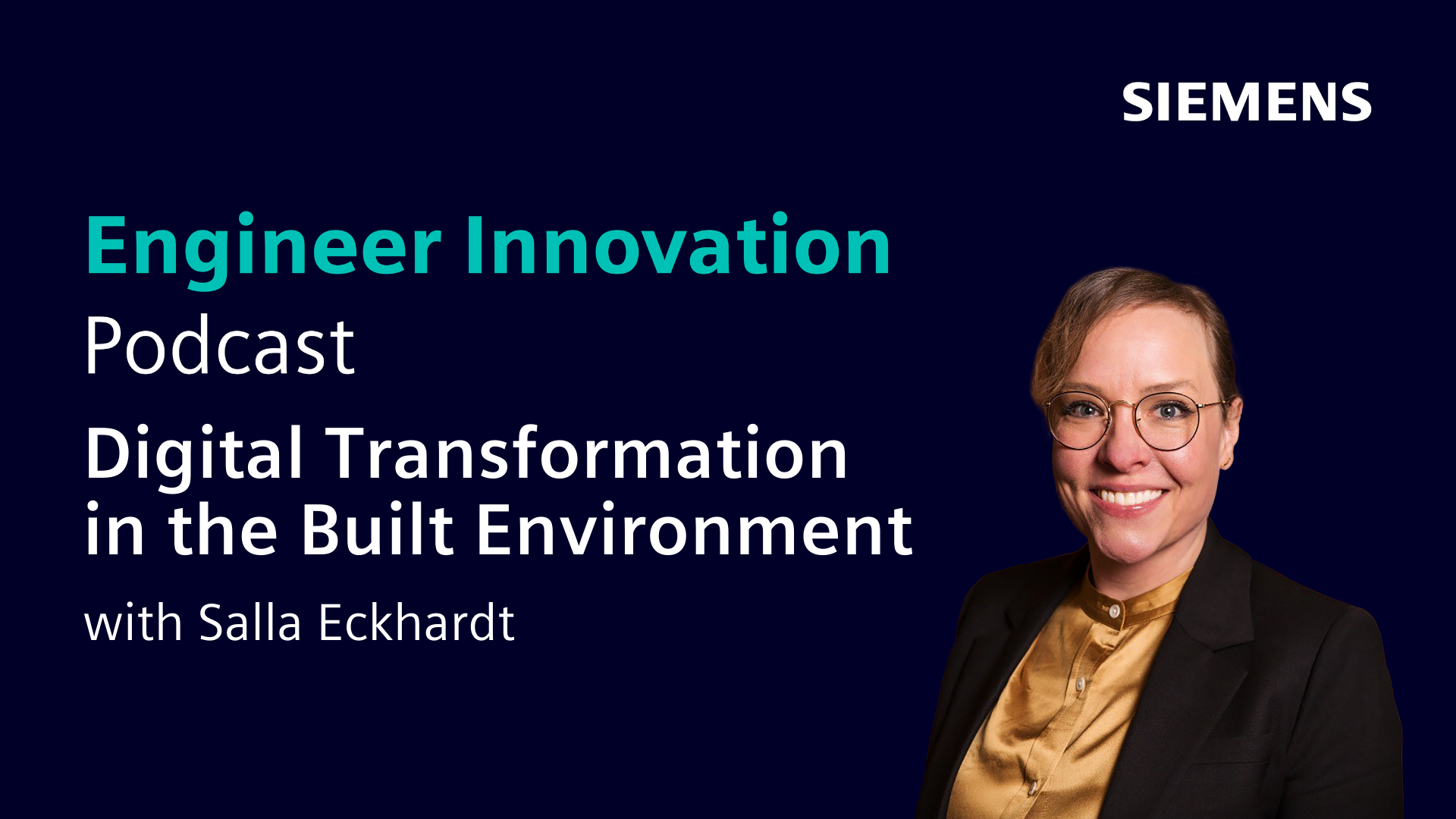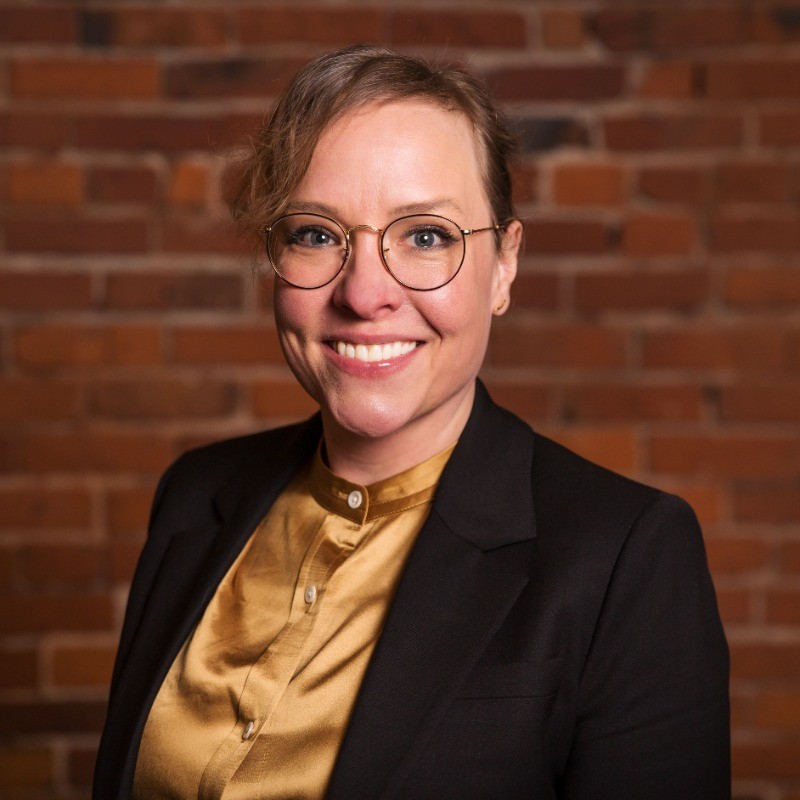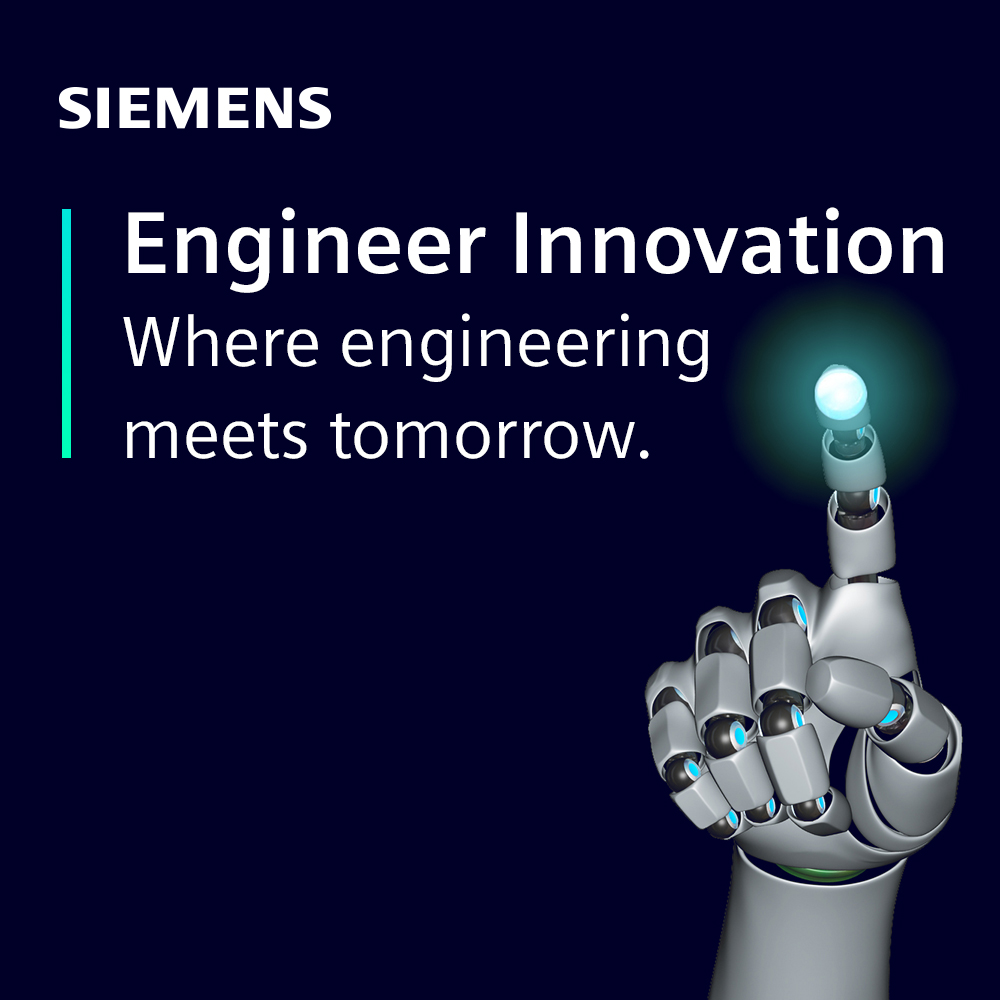Digital Transformation in the Built Environment with Salla Eckhardt

Listen to the Engineer Innovation podcast on
In this episode, we’re joined by Salla Eckhardt, Vice President of Innovation at OAC Services, Inc., which provides innovative building and process solutions to its clients. Salla discusses digital transformation in her industry and her experiences.
We talk about:
- Salla’s passion for the built environment
- Some of the biggest current challenges with the built environment
- Real estate versus the construction industry
- Why is digital transformation necessary in the built environment industry?
- Using simulations to identify and fix issues with the built environment
- Using AI in the built environment
- Using data to build more durable and resilient structures
If you enjoyed this episode, please leave a review. It would help get the word out about the show.
Find the show on your favorite pod catcher: Engineer Innovation podcast.
- Salla’s passion for the built environment.
- Some of the biggest current challenges with the built environment.
- Real estate versus the construction industry.
- Why is digital transformation necessary in the built environment industry?
- Using simulations to identify and fix issues with the built environment.
- Using AI in the built environment.
- Using data to build more durable and resilient structures.
Chad Ghalamzan:
Welcome to the Engineer Innovation Podcast, powered by Simcenter. This podcast is a show by engineers, for engineers, in which we explore how simulation and tests are contributing to a better and more sustainable future. Our guests bring in-depth knowledge of their specialty, and we have engaging conversations about the past, present and future of engineering. My name is Chad Ghalamzan.
Three little pigs. Each builds a house using different materials. The first two use straw and sticks to get the job done faster. However, that leaves them vulnerable to the Big Bad Wolf. The third pig doesn’t take shortcuts and builds a more resilient home. The moral: hard work pays off. That story was written almost 200 years ago. Is it time to update this classic tale? Should the last pig not just build a house of bricks, but its digital twin as well? Leveraging digital transformation in AI, can we do more for today’s most pressing issues, sustainability and social equality in the built environment?
My guest today is Salla Eckhardt. She’s the Senior Vice President at OAC Services, which provides innovative building and process solutions to its clients. Salla has spent her whole career pursuing her passion, finding a better future for our built environment. She has a deep understanding of why that industry needs to digitally transform. Hello, Salla. Let me start by asking you, why are you so passionate about the built environment?
Salla Eckhardt:
Thank you, Chad. I’m passionate about the built environment because my original career dream was to become an archaeologist, and I think that it had everything to do with Indiana Jones movies, but having visited the ancient ruins in Greece and learning about the history of humankind, it kind of triggered the second career dream of becoming an architect. And architects, they’re not the drawers of buildings. We don’t just draw buildings and get them built. We think about how the society is actually developing for hundreds of years to come and how communities can be made more resilient.
Then the built environment is a platform for all the activities that we do in our lives, and it’s related to the three piggies story that built environment provides us shelter, but it also provides us means and methods of congregating and doing politics, and we develop our communities overall. So, that’s why I’m so passionate about the built environment that it’s supposed to be enabling everyone and not disabling anyone. And I think about it as a platform for all the things that we want to do for humankind.
Chad Ghalamzan:
Yeah, shelter has evolved from just being where we protect ourselves from the external environment and becomes, like you said, a place where we engage in all of our most important activities, our home life, our work life, politics and government happens inside the built environment. So it does tell the story of human history, so I understand the link between archaeology and architecture, but the built environment also brings a lot of challenges with it, and you seem to be passionate about addressing those challenges. Maybe you could just elaborate for us as well, what are some of the challenges that you see with the built environment in this day and age?
Salla Eckhardt:
So, when thinking about what we currently manage as the built environment and how things have evolved over the thousands of years of developing buildings and bridges and infrastructure, etc., as we continue to improve something, then we need to compromise somewhere else. And when thinking about the end users and how we are now trying to build more sustainable, accessible environments that empower everyone, we can no longer just focus on the technical execution or technical performance of the buildings, but really think about the social and economic performance as well. And those are the new layers in design and engineering and in construction as well that we have a lot of legacy portfolio that is ripe for revamp so that they can be redeveloped into a smart environment that then create completely new types of capabilities for people.
But then we have a lot of need for new buildings as people have different capabilities overall. So the built environment shouldn’t be restricting anyone or anything, it should be empowering and enabling. And that requires more new type of design thinking and overall new type of thinking of what are we actually building and what is the purpose of those buildings? Especially now the COVID years, when everyone spent 24/7 time in their homes and are now making decisions, do they return back to the offices or do they return to how things were pre-COVID? We need to be thinking even further. We shouldn’t be thinking how things were in the past, but really thinking about what type of needs people now have and how those needs are, again, evolving.
We see a lot of generations that were the baby boomer generation now retire, or there’s a lot of nutrition in that generation overall and the new generations are completely different end users, and how do we capture those needs and continue developing the built environment that is more future-ready and doesn’t get antiquated just because we are building something based on our current needs and not thinking ahead?
Chad Ghalamzan:
Yeah, I think the pandemic caused both individuals and enterprises to rethink the built environment. What purpose does it serve? What is the best way to address those needs? Is just rethinking those spaces then the better future you envision, or is it more the smart city and leveraging the potential of building a whole area with the needs of a population in mind? Or is it a bit of both?
Salla Eckhardt:
It’s a bit of both because smart buildings, they create smart neighbourhoods and create smart regions and smart cities, and then they continue to expand from there into smart nations. So everything is now connected, at least digitally if not physically too. So, overall, when thinking about where should we be focusing, we should be focusing on what needs to be built now because that’s where you’re bidding your money on, but then you have to think about the financial implications for the next decades or hundreds of years to come that if you only focus on the capital expense planning and think about what it’s going to cost you to design and build something now, then you are not thinking about the operational expense planning that then is the bigger chunk of the game, and you will have multiple different owners making decisions based on what happened in the past.
So, we have to be able to think or analyse longer-term implications overall based on the data and evidence that we currently have in our hands. And that’s why the digital building lifecycle strategy is so important that we are not only thinking about the immediate needs of someone that is developing a building or an infrastructure or the immediate needs of those that are the first-generation owners of something that we really look into what is the data telling us as a trajectory, and how can we be more proactive and predictive rather than constantly reactive to what we have in front of us?
Chad Ghalamzan:
Right. And I think we’ll spend a good part of today’s conversation on data, digital transformation, and maybe go between intent versus what the data is telling us. But before we jump into that, I want to quote you for a second. I heard you say this statement and I think it’s a very interesting statement and it would be really interesting for our listeners to understand what you meant by it. The real estate business is global, but the construction industry is local. Could you help us understand what you mean by that?
Salla Eckhardt:
So when thinking about the different corporations that are investing into the built environment or creating the built environment, a lot of them are doing operations in multiple different countries. You might have talent joining your project from Canada or United States, but the project itself might be built somewhere in Saudi Arabia or Singapore, so overall, the project teams are becoming international. And I’m a good example of that as well that I’m working here in Seattle locally, but I’m originally from Finland.
The industry overall, it’s blending now. It’s not that people that were born in Seattle are the only ones that work on construction projects here in Seattle. The industry is changing, and it’s creating new opportunities for people that have various backgrounds. And even though the buildings themselves built with the local workforce and built on site, people might still be coming in from other regions to make that happen, and it’s tied to sustainability aspects of our built environment too. How do we think about sustainability, not only from the environmental sustainability perspective and tying it into that local region, but thinking about the socioeconomic sustainability, what kind of impact does that project have on much wider or bigger region than just the piece of land that you are working on?
So the projects themselves, they are becoming more global and the business is global, but it’s also local. So, it’s local now, and there’s a lot of pre-manufacturing and the prefabrication happening overseas, and things are being imported and exported. So the industry itself is going through generational transformation as it is going through a digital transformation, but then there is the third megatrend that it’s all of a sudden becoming international and global as well. And it’s happening hidden. It’s not so obvious because we are working with so many subcontractors and suppliers, etc., that it has kind of split us through the cracks. It is differently there.
Chad Ghalamzan:
What’s the bigger impact of this becoming now a global phenomenon? Is it the difference in regulations from each area? Is it the difference in the manufacturing or the construction materials? Is it the amount of data we can gather when we look at now the picture globally versus locally and can make better decisions? Or again, is it a bit of all these things?
Salla Eckhardt:
It’s a bit of all of those things, and then, it’s the talent pool that all of a sudden you have the entire world in your fingertips to hire the right architects or engineers or construction management consultants to help with your project. And that way, you don’t have to be limited with what you have in the two-mile radius or a little bit longer radius, but you can really reach out to anyone that has the knowledge and the know-how that you need for your project. And digital transformation and digital platforms now enable that. You don’t have to be limited anymore. You can expand your network and then continue expanding from the perspective of where you’re acquiring and supplying your materials or products, and that way, choosing what’s best for your project and best for the long-term strategy.
Chad Ghalamzan:
So that’s taking the AEC, which is the Architectural Engineering and Constructions, to AECO, adding the organisational part to it, but are we seeing that really coming to fruition? Are we seeing it become AECO or are we still in a stepping stone place between AEC where the organisational side and the data-sharing side isn’t really coming through as fast as we would like?
Salla Eckhardt:
That’s a good question, especially during COVID years that kind of pivoted things. But definitely when thinking about the workforce and the future of work, baby boomer generation has now retired, and we have Gen Xers, Millennials, Gen Zers, and then what comes after that all working on the same project. So you have multi-generational management, and then you have the traditionalists and those that are very conservative thinkers of the construction industry blended with people that are more futuristic and more innovative, more digital, and definitely there is now opportunity to kind of choose the adventure, and it’s happening all at the same time.
There is so much work to be passed around in the building environment industry that it’s never-ending. So, there is a piece in the puzzle for everyone, and they don’t have to be necessarily competing for the same piece. It’s just a matter of finding what is the best type of project for the best type of team for that project. They are not competing methodologies, but they are more adding to each other and supportive of each other that you can coexist with a very traditional and conservative way of getting things done or you can take that digital route, and that’s one of the transformations and disruptions that the industry’s going through right now. COVID definitely pivoted things, and this year overall is pivoting things even more, and that’s why this year has been so interesting.
Chad Ghalamzan:
Well, I think you’ve already started to answer this question, but maybe you can elaborate a little bit more. Why does the built environment industry need to digitally transform?
Salla Eckhardt:
There are multiple reasons for it. One of the reasons is that it’s been a very labour-intensive industry, and it’s been one of the industries that is the biggest print maker or print deliverer for families. And it has had the reputation that if you don’t have the opportunity to go to school, you can always find a job in construction industry. But at the same time as the baby boomer generation retired, we have shortage of having human labour. So we need to be able to build bigger, faster, higher quality, and all the things that are pressing, and at the same time, we need to realise that there’s no endless supply of natural resources or materials, etc.
So, the demand for new buildings and new built environment is increasing as the population on the planet increases, but everything that we have is already here. So if we digitalise, then we can optimise the amount of resources that we actually need, and we can make more educated decisions on what should we do? Should we be retrofitting and renovating and taking the deep renovation route with our existing built environment or do we continue building something new? And having access to structured data and reliable data and having the digital truth will enable us to make more educated and better decisions, so that we don’t end up creating issues that then later on become bigger problems. That we can really have more transparency into multiple layers of decision-making and work as a team.
That’s something that only digital way of doing things will support. People that are not present in the same room looking at paper drawings, they are excluded from the decision-making processes, but if you add digital platform and enable people to collaborate digitally, then you are tapping into the brain power and resources that remote and hybrid coworkers have.
Chad Ghalamzan:
You mentioned that this is for better quality, but when we talk about quality, we’re not just talking about the aesthetics or the finishing of these buildings, we’re talking about less energy consumption, we’re talking about improving their lifespan and increasing their durability or being more resistant to changing environmental factors. Is that a fair statement?
Salla Eckhardt:
Yes. And when thinking about the technical performance of the buildings, then it’s directly tapped into the financial performance as well, that when thinking about things as simple as owning a home. And if you choose to live in a single-family home or a condo, you are going to have your monthly cost, and there is a limit for what people can afford, so it taps into the affordable housing discussion that my rule of thumb for affordable housing is 30% or maximum 35% of your own income, and that’s where your affordable housing limit is, that if the cost of living and owning a piece of real estate continues to rise because the expense of energy or renovations and everything continues to rise, people can’t afford the increasing prices and the inflation factor.
So if we have a digital twin available about something that we own, then we can continue to harmonise and optimise the technical performance and tie it back to the financial performance, and that way understand that I’ll be on par with what we are actually making in terms of our income versus what we are actually having to pay for our living and housing. It’s the technical performance and monitoring that, optimising that, but more importantly, it’s about the financial performance that we need to be fiscally responsible and financially responsible, so that we don’t end up bankrupting home owners or building owners and property owners.
Chad Ghalamzan:
Yeah, there’s always a trade-off to be made. We have to consider that if housing was already out of the reach of some, if we increase the cost, we’ll make that problem even more acute.
You mentioned the data. I guess it goes down to the intent versus the data. So when we have an architectural plan, that’s the intent of what the building is, but then, when it’s actually built and in operation, we can collect the data and then get a better understanding of what the actual performance of the building is or what the actual energy consumption of the building is or any of these other technical specifications that we can now, with the sensors that we can instal and data we can collect, we can actually gather a lot of information about a particular building and then use that to analyse the performance.
So, the question becomes, is using simulations a way to help improve some of the previously identified issues with our built environment, and is that part of what the digital transformation allows us to do?
Salla Eckhardt:
Definitely. Simulations and even animations, they’re a way of communicating to people. Are they dealing with something that can run business as usual or is there an indication that you should do something about it? So, the simulations they give a heads-up on, do you need to do maintenance on things? And when thinking about maintenance, the cost of maintenance is peanuts compared to if you have to go and do a deep renovation. Whatever method people are comfortable with so that they can learn and understand and comprehend what needs to be done, then it’s a pick and choose your own adventure.
But they need to realise that if there’s an indicator that something’s not operating as it should, that they need to go and check that. Do they need to do a little bit of maintenance, change a filter or anything like that? Or is it that they already have to budget for retrofitting something, that something is already breaking down and if you go and retrofit a part in a system, then it’s a little bit higher cost than the maintenance, but you are not having to retrofit the entire system. So repair is a little bit higher cost than maintenance, but you’re not in the retrofit cost of the project, and the project complexity overall, it’s easier. It’s not as time-consuming either.
But then, if people continue to ignore the early indicators and creating issues that then accumulate into problems, then eventually, something will give up if the part that is not replaced causes a system failure that all of a sudden your entire system needs to be pulled out and replaced because you ignored all the maintenance signals, then you are accumulating your digital debt and the overall renovation debt that you have to address and someone needs to pay for. And then, if there’s the opportunity for replacing something and retrofitting something, then it’s a valid point in time to really think about is it the time for deep renovation?
Hence, if you’re dealing with a building that is, let’s say over 50 years old and you have to retrofit an HVAC system, then doing a technical inspection of the building and checking the air tightness of the building envelope and the roof, etc., and looking into the overall technical condition of the building, you’re tapping into how much renovation debt you have, but tapping also into how much digital debt you have because you might not have all the data available, but the cost of deep renovation is much higher than the maintenance.
So overall, what the digital twins and simulation, animations, digital platforms are creating is buying new pie. So you’re not over-investing into your projects and doing something too early when you still have technical lifecycle left for certain parts or systems or materials in your building. So you want to avoid over-investing because eventually, you’re going to pay for the same building multiple times through its technical life cycle, but then, if you don’t invest just in time and you let things break down, then you are adding more costs to your project because it gets more complicated, and you have more problems in your hands to be resolved.
Chad Ghalamzan:
Yeah, you could take action with predictive maintenance, and that will reduce your overall cost, for sure. I guess when you look at the built environment compared to, let’s say transportation, and you take someone with a single dwelling home and they have a vehicle, after 10, 15 years, when the maintenance cost ceases to be reasonable to maintain, they just change vehicles. With the built environment, I guess we have the issue that we don’t necessarily retire our built environment in such a short lifetime, and we have to do a lot more retrofitting and going back and maybe addressing concerns or issues in the original plan that did not either maintain their performance or does not meet the current needs.
But also, when we’re looking at building, and because there’s a large portion of the world where the built environment is not as developed, let’s say in North America or parts of Europe, where they’re building it from scratch, we can leverage this data to make better decisions upfront. And I think that ties into your digital building lifecycle framework. Maybe you could talk a little bit about that and how each of these problems have a different solution that we need to look at. How do we address retrofitting versus now when we’re building greenfield and build something from scratch and how we can tie data into both of those to make better decisions?
Salla Eckhardt:
I love that you brought up the greenfield aspect of things because that taps into regional development, and it’s one of my favourite topics to address that tenant improvements are different than greenfield projects. And this is super important for our clients to understand that greenfield, brownfield, grayfield, and blackfield projects are always regional developed and tied back to the community’s development and redevelopment that when thinking about how metropolis areas are developing and how there is urban sprawl as people want to have bigger homes and they buy homes further out from the downtowns, it means that we have to invest into new infrastructure and continue building longer pipelines and longer district heating networks, etc., and that is all adding to tax dollars that need to be collected.
People always have to think about the financial side of things and how new development is impacting how the taxes are collected and where they’re actually spent. So that’s why we need to be thinking about should we be retrofitting existing communities and doing brownfield, grayfield, and blackfield projects, and shine light on what these fields are. Greenfield are pasture lands and forest land, so it’s virgin land, has never been touched and never been developed. Brownfield is when you demolished something, and it’s the colour of the dirt. You might have underground infrastructure, but it’s all being pulled out and replaced. Grayfield is something that you have old business parts that are underutilised, and that’s basically what post-COVID office spaces and campuses might be. So you have asphalt fields, and that’s why it’s grayfield.
And blackfield is usually oil fields that is contaminated soil, colour of oil. So these different field projects, they have a different multiplier to how much cost you need to preserve for it and budget for it compared to the original greenfield project, so a blackfield project is about three times more expensive because you have to do the soil changes and build everything, demolish everything first. But then when thinking about the other side of things that you have existing buildings, then tenant improvements are always adding something that doesn’t exist and retrofitting is replacing something, and deep renovation is adding sustainability features and improving the total technical condition of the building.
So everything ties into what are you ready to invest in and what your investment strategy is. And then, having the digital building like the cycle strategy that how do you collect the digital truth about that piece of land or that particular property, so that when you are making decisions about do you continue to improve that and preserve the historical layers of that architecture, it kind of starts to touch base with, does your building have architectural value to it? It’s some great name design or is it something that someone drew on the backend of a napkin and went and built it?
We shouldn’t be afraid of demolishing things. If something is already old and in bad condition doesn’t automatically mean that we should just go and demolish it and build something new. That’s the political discussion to have that how do we continue evolving the communities so that we preserve historical layers and learn from the past? And that’s what the digital building lifecycle is about, that we accumulate all the relevant data or supporting the educated decision-making of the future so that we don’t end up repeating our past mistakes but continue learning from them?
And eventually, the utopia about the digital building lifecycle is that all the damage that the humans have caused for our environment can be reversed because now we have artificial intelligence and all kinds of things to help us save ourselves from our own limited thinking and limited knowledge that if we can simulate and animate things that how might things go in the decades to come, etc., then we can make better decisions and aim at improving things rather than just get things done quickly and then move on.
Chad Ghalamzan:
Or avoid unexpected surprises if we have that digital information stored. So if a building was built using, let’s say asbestos, you would know that in advance and could take the right measures when decontaminating if you were going to do some sort of retrofit.
There’s obviously a lot of power in having that data, and you just mentioned the buzzword of the year, AI. Is there other possibilities when you’re looking at AI in the built environment besides sifting through the data in terms of making better decisions? What else does AI in the built environment offer as a possibility, in your opinion?
Salla Eckhardt:
Now that you mentioned asbestos, you’re tapping into another area of passion of mine that if we have structured database.
Chad Ghalamzan:
Not for asbestos, I hope.
Salla Eckhardt:
No, it’s like asbestos equals lung cancer, but when thinking about if we already design our buildings using building information model, and then we tie the building information models for a digital twin so we know how things are operated and how things are changed over time, it’s creating a structured database that the AI can then analyse. And if we, down the line in history, realised that the best materials that were devolved and were applicable for everything turned out to be cancerous or hazardous and unhealthy for people, then we can have a really quick analysis of where do we actually have those materials?
Then also, we can analyse what is the combination factor of different materials and how that combination factor is creating situations that are unfavourable. And this is related to, if you add moisture and heat, then you have fungus among us and mould issues that then ties to air quality issues that people can’t necessarily see, but all of a sudden people have allergies and respiratory symptoms. And if you get exposed to mould and get sick, then you can never go into a building that has mould into it. You will automatically get sick every time. And these are the things that you have to know the combinations that are the cause and effect of things.
And if you don’t know those combinations, then you don’t know what you don’t know. So AI could be trained to look for different combinations and run the analytics pretty quickly, and it’s as simple as different metals that we have historic buildings that have copper roofs and copper spouts. And if you combine copper with steel, the sequence of is it that steel roof and copper spout or copper roof, steel spout that you either create a situation for corrosion or not? And it’s something that you either know or you don’t know, but the AI could be trained to look for these type of factors in the attributes in the datasets.
Chad Ghalamzan:
Yeah, there’s so much data no one could sit through it manually. You would need to use machine learning and AI to maybe start making those causality connections, which is fascinating, actually. When we talk about AI and we talk about digital transformation, what I notice is, buildings are ubiquitous. Ideally, we all live somewhere, we all work somewhere, and we all go attend recreational events and what have you. We see it all around us, but all these issues you’re bringing up, it applies equally to almost everything we build, the manufacturing, whether it’s a static building or a moving vehicle or all the heavy equipment, these are all the issues that AI allows us to address these causality issues.
And built environment, obviously, is something I think we see and maybe don’t notice all the complexity and engineering that goes into each aspect of it. And, of course, the bigger the building, the more complex it is. Do you have any specific examples of any of these projects you’ve worked on or know of where AI might’ve been used to improve the building performance?
Salla Eckhardt:
AI is so new that it’s been prototyped in projects, but they are just to learn how to structure the data and what might be done with the AI. AI overall, it’s developing really fast, but it’s still very new to commercial market, so it still requires a little bit of training and education of people, so that the end users understand what to do with the AI rather than AI dictating the people that what it can do is done. But I’m really hopeful that once people kind of understand the logic of AI and understand the logic of creating a structured database, then we can start having the different applications of things.
And I think overall, well, safety comes first in built environment all the time. So, we really need to think about the decision-making points, what do we want to achieve so that then we know exactly how to apply the AI. I’ve seen beautiful renderings created by AI, but it’s kind of a smoke and mirrors and circus trick to have the renderings made by AI. They are beautiful, but then they don’t necessarily support decision-making of what kind of social or economic or sustainability impact does it have on the building environment, but it’s coming.
People have different types of needs and when thinking about the built environment as a resource bank, then that opens completely new types of ways of using AI. And it has nothing to do with reading drawings or generating 3D models, but it’s about structuring the data related to what materials we have in our built environment and where those materials are so that they can be collected correctly and shifted through when the existing built environment might be demolished and recycled. So there are applications that are low-hanging fruit, but we need to train the AI to identify the pieces of data that we actually need and go from there.
Chad Ghalamzan:
What about with respect to digitally transforming the industry? Have you worked on projects where you’ve seen the embracing of digital transformation of using digital twins or data that we’ve collected on a project that would enable better decisions or more efficient building operations or achieving more sustainable building?
Salla Eckhardt:
Yes, definitely. And that was how I spent my past four years, but those projects are hush-hush, so I can’t address them or share anything about them, but my entire career has been related to innovation and doing things that are not necessarily possible yet, but have been researched and proven to become possible. So it all boils down to, do we have reliable data available and accessible for people that are developing the tools? And then, we need to have more open discussion about what kind of decisions people are aiming to make based on what the AI can support and what the digital transformation can support, and that way enable the digital tools and digital platforms to level us up, give us the superpowers as decision-maker. So AI is not something that is going to be replacing human beings as decision-makers or doers, it is to augment and enhance us.
Chad Ghalamzan:
What do you think made those projects a success then? If you can’t talk about the particulars of it, what was the driving factor you think that made them successful projects?
Salla Eckhardt:
It was the collaboration of people that everyone has a different perspective into the same problem. When we are thinking about building a building, an architect has a completely different point of view than a structural engineer or the specialty engineers or the owner or the construction management company or the contractors. So, even though we are all creating solutions for the same problem, how do we get a building built or an infrastructure built? Working in a silo will only get us as far but really creating an environment where people can share their perspective and their knowledge of how they would solve the thing, then AI and digital platforms and the hybrid teams together will generate a much better end result and the outcomes than what we would do if we were continuing to work in silos and working alone and taking the traditional route.
Chad Ghalamzan:
Let me ask you this, straws and sticks or bricks. Are we pursuing more quick, cheap, fast solutions, or are we seeing a movement in the built environment to build more durable and resilient structures using all the data we can now collect?
Salla Eckhardt:
That’s a really interesting question because I’ve started thinking about how post second World War, there was a really rapid rebuilding era, and things needed to be built fast, and the engineers calculated that the average technical age of a under building was 30 years, and they were planned to be demolished and something else to be built in replacement, and that was the era of modernism. But then, after the 30 years, people realised that these buildings, they’re still standing and we live in this buildings and life is pretty good, but we kind of need lipstick on a pig and a little bit of repairs. So it was a surprise that something that was engineered or planned to last on 30 years was like, “It still has more years to go. We just have to do a little bit of updates.”
But when thinking about the ever-changing needs of end users today, we don’t necessarily need to build everlasting buildings, but we need to be able to create something that can morph as the needs of end users change. So when thinking about how old the pyramids of Egypt are, they were built to last very, very, very long time, and they are built from stone. But then, there is a need for having the straw buildings too. If something is a short-term, temporary structure, then it shouldn’t be creating waste. So it’s more about planning for waste removal and waste reduction and thinking about how do we create resource banks, and how do we continue to recycle and upcycle what we already have and reuse things when we already have them close by.
Now, overall, when we are thinking about what type of materials or systems do we choose for our buildings, we first need to do the cost engineering system and exercise that we shouldn’t be cost-estimating anymore because that’s trying to make the best guess, but not really necessarily comprehending or knowing what we are budgeting for. So we need to cost-engineer things first and then value-engineer the different suppliers and the final materials. The value engineer shouldn’t be removing and eliminating the cool factors and the ambition from buildings, but making sure that if we have cost-engineered the size of the project, then we value-engineer or optimal lifecycle and performance of the materials and systems that we end up choosing, and that ties into the lifecycle thinking and how long and how durable do we plan something to be. So, it’s kind of a complicated answer, but that’s why we need to simulate things and analyse things.
Chad Ghalamzan:
Data-driven decisions with purpose in mind. That’s the way to move forward and ensure we don’t create risk and waste without understanding what those risks and what the waste is. I think that’s pretty much universal at this point as we look at the ever-growing need for sustainability and leveraging all the technology that we have available today. Salla, it’s been a fascinating discussion. Thank you so much for your time. I hope you’ve enjoyed it as much as me.
Salla Eckhardt:
Thank you so much, Chad. And thank you, Siemens team.
Chad Ghalamzan:
Thank you for listening to the Engineer Innovation Podcast, powered by Simcenter. If you’ve enjoyed this episode, please leave a five-star review and be sure to subscribe so you never miss an episode.
Speaker 3:
This episode of the Engineer Innovation Podcast is powered by Simcenter. Turn product complexity into a competitive advantage with Simcenter solutions that empower your engineering teams to push the boundaries, solve the toughest problems and bring innovations to market faster.

Chad Ghalamzan – Host
Chad Ghalamzan is a computer engineer with over two decades of experience in sales and marketing for the simulation and test industry. He co-hosts the Engineer Innovation podcast and creates content for Siemens Digital Industries Software. He didn’t start the fire.

Salla Eckhardt
For 20+ years, Salla has been digitally transforming the face of the built environment industry. Formerly Microsoft’s Director of Digital Building Lifecycle and Innovation, she brings the ability to lead multi-million-dollar programs and propels diverse teams to company-wide innovation through BIM, digital construction, and digital twin technology.
Take a listen to a previous episode of the Engineer Innovation Podcast: Engineer Innovation: Breathing Life Into the Digital Twin on Apple Podcasts

Engineer Innovation Podcast
A podcast series for engineers by engineers, Engineer Innovation focuses on how simulation and testing can help you drive innovation into your products and deliver the products of tomorrow, today.
Listen on:
Comments
Leave a Reply
You must be logged in to post a comment.








Licensed construction contractors adhere to ethical business practices and transparent operations.